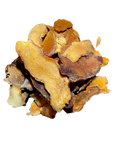


Solomon's Seal Root
Botanical name: Polygonatum biflorum
^^Sustainably Wildharvested
Polygonatum biflorum, commonly known as Solomon's seal, is a perennial herb that belongs to the Asparagaceae family. This plant is native to North America and parts of Asia, typically growing in shady, moist woodlands and forests. Solomon's seal is characterized by its arching stems, oval leaves, and small, bell-shaped flowers that hang beneath the leaves, giving it a distinctive appearance.
In herbal medicine, Solomon's seal root has been traditionally valued for its potential benefits in supporting joint health and soothing inflammation. The root can be prepared as a tea, tincture, or poultice, offering a mild, earthy flavor profile. Historically, Solomon's seal has been used by Indigenous peoples for its reputed ability to promote overall wellness, particularly in relation to skin and digestive health.*
*These statements have not been evaluated by the Food and Drug Administration. This product is not intended to diagnose, treat, cure, or prevent any disease. For educational purposes only.



